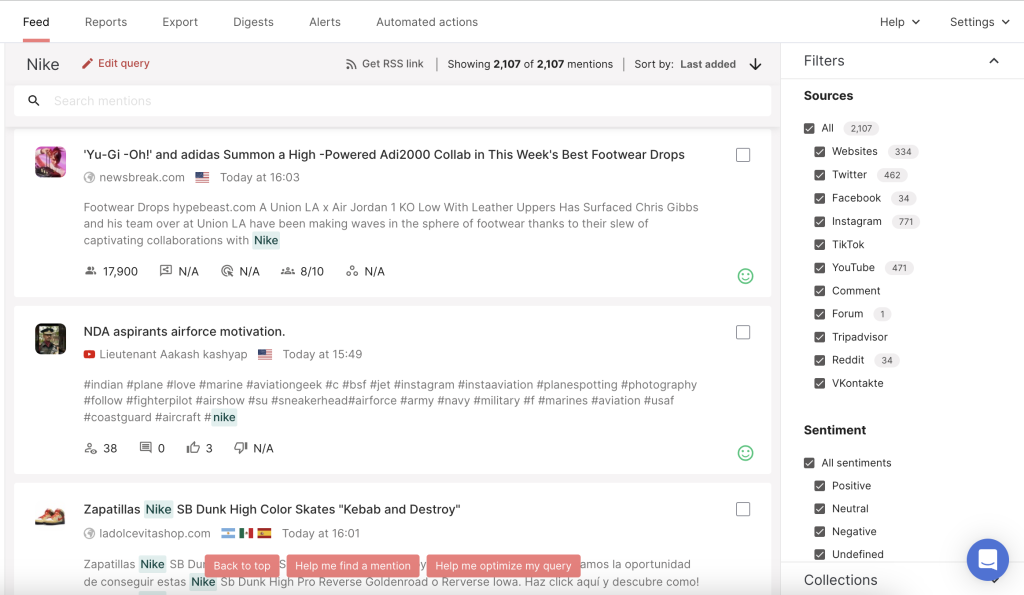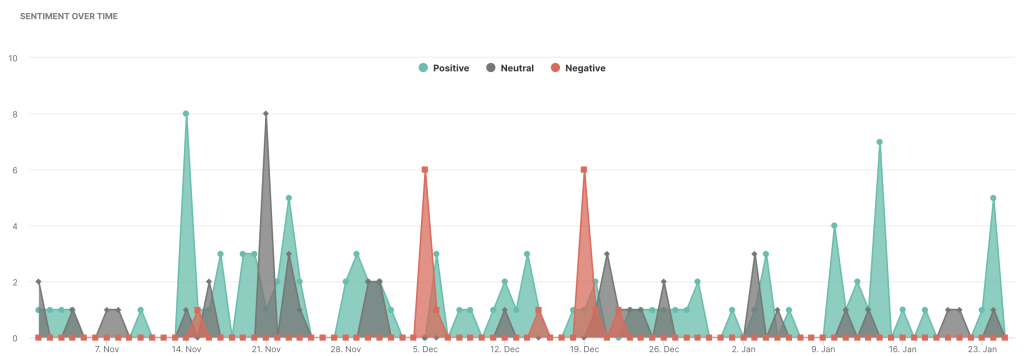You’re probably already making use of monitoring tools for delivering bespoke social listening and media monitoring across the internet. Did you know that you can use such tools for more than that, though? Let us shed more light on how Determ can assist with…generating content ideas.
Yes, you’ve heard it right. Content ideas straight from your social listening tool. Much more than just monitoring keywords, mentions, and sentiment.
? Read Creating a Marketing Strategy that Works: Benefits, Steps, Tools
Despite their best efforts, even the most creative social media managers and content creators can hit a creative block. And that’s okay – no one can be creative 24/7. Instead of forcing them to come up with brand new content ideas, they can now stay inspired by leveraging what’s already right in front of them. The client feedback, needs, and concerns of their own customers.
Today we’ll show you how to use the social listening tool, Determ, for precisely this purpose – diving deep into the content ideas machine.
How to use media monitoring for developing content ideas
#1 Use real-time feeds to come up with fresh content ideas
Social listening tools deliver insights in real-time. You can react to selected mentions, pretend they never happened, or…use them to inspire your content ideas.
Keeping an eye out for mentions and links from online sources can really be useful for generating content ideas.
For example, let’s say that you are organizing a marketing webinar. Real-time mentions are not only valuable for feedback but can also be used to inspire post-event content. You can check what is being said about the event as it happens and gather mentions for executing content ideas during and after.

Here are just a few content ideas:
- a listicle of best presentations
- a summary article of key takeaways from a keynote speaker
- a user-guide listing X reasons why the event stood out from the crowd
- a sneak peek at an upcoming event (considering the current one is a blockbuster)
There’s nothing more exciting than writing about what’s happening at (or very close to) the moment you create content. That’s the basis of the How-Now-Wow content framework too, for which Now means relevant and current content ideas.
You can monitor online sources in real-time with Determ in order to know what, when, and where customers are talking about your service or product.
It gives you an opportunity to develop relevant content, create video materials, and create publications that address problems before they become too big to deal with. In addition, you can react quickly and take action accordingly, gaining more insights and coming up with new optimized content ideas.
#2 Use competitive analysis to create an advantage
The B2B world revolves around comparisons of products or services. The more in-depth they are, the better.
All these comparison guides may appear the same. Many point out the similarities and differences between the same features over and over again. As such, they will not help users make the right product choice.
While it is vital to compare and combine features in detail, the human element is even more crucial and can be an interesting differentiator.
When creating content around comparisons (comparison pages, use case guides for WordPress hosting, or buyer guides, just to name a few examples of content marketing ideas), you should take into account an objective viewpoint and real-world user experience.
Read 11 Tips to Make Content Marketing Work for Small Budgets
And that’s exactly what awaits you with Determ.
By using its built-in competitive analysis tool, you can see what real users have to say about your products and your competitors. Thay way, you can draw parallels and present your offer as a better alternative.

For example, let’s say that you’ve invented an e-mail marketing automation solution. The fact that yours is not the first app on the market means you have plenty of competition. So, it would be useful to quickly ramp up your content ideas thanks to social listening. In addition to highlighting areas to compare, you can spot similar patterns and areas for improvement that might not necessarily be mentioned by your competitors.
It would be impossible to gain these insights anywhere else. Yet, they could end up being the most valuable and natural aspects of your comparison.
On top of that, your competitors won’t be able to duplicate it. Hence, you can cover your findings in even more ways than just a single comparison page. For example, you can create a series of user guides that highlight the benefits and differences you identified during your media monitoring research.
What’s more, with the right keyword choice, you’ll be a step closer to creating captivating and SEO-optimized content. So it’s a win-win-win: content that’s relevant, unique, and drives traffic.
#3 Use sentiment analysis to discuss topics your customers love
One of the most valuable features that a social media monitoring tool can provide is sentiment analysis. It may help you determine your audience’s passion for a topic and evaluate the business sense of covering it in your content plan.
Insights derived from sentiment analysis are extremely powerful when evaluating your content ideas.
Automatic Sentiment Analysis is a metric that Determ determines itself when analyzing mentions. Each mention’s sentiment is calculated according to the number of positive, neutral, and negative words that appear within it.

This can help you figure out how your customers feel about you and your product. Furthermore, which features or aspects are pleasant for them, and which are objectionable.
For example, if you’ve just launched a new collection in your e-commerce store, checking the sentiment analysis can help you identify some content ideas for how to tackle the launch and what to focus on. Recognizing shining and shooting stars is incredibly helpful for the overall strategy.
Advanced filters make it easy for you to find out which channels are bringing in potential brand ambassadors. Moreover, to create content that is tailored to a particular audience.
#4 Utilize real-time alerts to stay on top of trends while they’re hot
Hot coffee sounds way better than cold, doesn’t it?
The same goes for online topics: the hotter it is when you cover it, the more likely you (and your audience) are to react positively to it and make it go viral.
To make sure that you never miss the boat, you should leverage real-time alerts for fueling your content ideas strategy. And it’s something Determ also delivers.
Real-time alerts let you know immediately whenever the keyword of your interest is mentioned. In this way you can be the first to jump on the topic and cover it.
For example, when your competitor’s services go down, real-time alerts can let you know about it so you can create relevant content on the fly. Content ideas around a particular topic can be created when the trend for a particular product gains popularity because a social influencer posted about it.
Instead of tracking manually (and very often missing), you can receive a real-time alert on your email or though Slack.
#5 Validate your existing content ideas
It’s likely that you already have some content ideas for your brand. You may have carried out extensive research on SEO queries, competitive analysis, and maybe even started creating some content briefs for your writers.
That’s great, but are you sure that you have validated your content ideas enough to achieve your business goals?
In 2021, there’s no room for guesswork, nor for poor content. Social listening with Determ gives you the unique opportunity to discover whether or not your content is resonating with your audience, or if it rather leaves them cold.
To make sure that your target group is interested in your content (and will therefore familiarize themselves with it and convert), you should:
- validate the SEO potential of your content ideas (you can do so by using SEO tools such as Ahrefs or Semrush and keyword research)
- check sentiment and possible mentions around the topic to confirm that an idea is worth mentioning (which is exactly what can do in Determ)
- identify the best format for your content (you may find out your audience is more engaged with e.g. videos or share a lot of insights in Shopify product reviews) and add them to your content ideas.
For example, suppose you had an amazing idea about covering social media myths. It seems like a total hit to you and your SEO tools don’t convince you otherwise. However, you may find that social media monitoring shows fairly low engagement and a lack of interest in this thread. This does not mean you should not cover it at all. But it should probably take a back seat to other content ideas.
There is a reason why social listening has acquired its name: it is indeed about listening on social/online. By checking what your audience is into, you can adjust your existing content ideas. By combining their preferences with your capabilities and resources, you can get a successful content cocktail that’s pleasant to drink.
Sometimes even a tiny content tweak can bring amazing results, so why not try?
#6 They ask – you answer
Whoever has never asked about anything online cast the first stone.
The online world has several characteristics, including an ease of asking questions. You just shoot them into the air and wait for the answer to fall.
Sometimes it doesn’t land, though. And that’s where your chance lies.
With social listening, you can easily identify what questions are asked, what concerns are shared, and what issues your potential users have. While you won’t be able to solve every problem or cover every topic, it’s likely that you can prepare some content ideas based on your findings. In Determ, you can easily narrow a search down and check if there are some potentially attractive areas to cover.
For example, let’s assume that you have a photo editing mobile app. Social listening can help you identify topics related to what your product solves. If you see many questions asking “what are the most natural filters?”, you may want to turn the answer into one of your most successful content ideas.
And the sky’s the limit here.
You can use this research, just to name a few ideas, for:
- writing briefs and regular blog posts (especially if you want to make money blogging)
- creating FAQ (Frequently Asked Questions) snippets
- preparing guides and how-to articles
- drafting scripts for video tutorials and graphics
- composing your social media communication
And all of those with a huge amount of insights direct from your audience, so you can be sure your content ideas will be noticed, acknowledged, and appreciated.
Over to you
With Determ, you can take your content ideas to the next level thanks to first-hand experience and feedback from those you care about the most – your potential and existing clients.
Media monitoring gives you all the opportunities in the world to tackle content plans and creation, as well as to give them the human element of first-hand insights that are almost impossible for others to copy.
Could you do it all without social listening? There’s a chance that some of those ideas which you would never otherwise come up with were executed straight away by your competitors. Eventually, you may find some workarounds, but only with professional media monitoring can you easily come up with great content ideas on the spot.
So, are you waiting, or are you creating? Check out what Determ has up its sleeves and revamp your content ideas.



